May 25, 2007
Air Date: May 25, 2007
FULL SHOW
SEGMENTS
Rachel Carson Remembered
/ Bruce GellermanView the page for this story
Living on Earth commemorates the life and legacy of Rachel Carson, the science writer who inspired the modern environmental movement in America. Carson would have turned 100 years old this week. Her landmark book "Silent Spring," in which she warned of the dangers of DDT and other synthetic pesticides, is widely considered one of the most important books of the 20th century. Living on Earth's Bruce Gellerman visited the Cape Cod Museum of Natural History as curators were preparing the nation's largest exhibit celebrating Carson's centennial. (12:00)
Emerging Science Note/La Brea Tar Pits
/ Meghan VigeantView the page for this story
Living on Earth’s Meghan Vigeant reports on bacteria discovered in tar pits that could be used to break down oil in the environment. (01:30)
Learning In the Shadow of Coal
/ Jeff YoungView the page for this story
For our series “Generating Controversy: the Changing Climate of Coal,” Living on Earth's Jeff Young visits a West Virginia community where schoolchildren get their lessons in the shadow of a coal mine - literally. Some residents say the massive mountaintop removal coal mine and its lagoon of liquid waste threaten the school's safety and they're determined to get either the school or the mine moved. (16:00)
Coal Country Crooner
View the page for this story
Host Steve Curwood speaks with singer-songwriter, Kathy Mattea, about her soon to-be-released album "Coal.” Mattea plays some songs and talks about growing up in West Virginia coal country, her relationship with the 'black gold', and how mining and burning coal is affecting the environment and the people in her native state. (17:00)
Show Credits and Funders
Show Transcript
HOST: Steve Curwood
GUEST: Kathy Mattea
REPORTER: Bruce Gellerman, Jeff Young
SCIENCE NOTE: Meghan Vigeant
[THEME]
CURWOOD: From Public Radio International - this is Living on Earth.
[THEME]
CURWOOD: I’m Steve Curwood.
When coal is mined and sent to market, a toxic slurry is usually left behind. There have been major disasters when coal slurry dams fail, and that’s got some folks in a West Virginia town mighty worried.
WILEY: When you’ve got two-point-eight billion gallons of toxic sludge sittin’ over an elementary school it’s, it’s not good. I feel this is willfully and knowingly leaving these kids in harms way, you know this is a form of child abuse.
GELLERMAN: Also, at the hundredth birthday of environmental pioneer Rachel Carson, a look back at her message.
DWYER: I think what Rachel was trying to explain to people is that just because the government is trying to tell you that something is OK doesn’t mean it’s OK. If you have some reason to question something, it’s your duty to do exactly that.
CURWOOD: Rachel Carson and more this week on Living on Earth. Stick around!
[NPR NEWSCAST]
ANNOUNCER: Support for Living on Earth comes from the National Science Foundation and Stonyfield Farm.
Rachel Carson Remembered
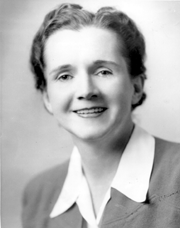
Rachel Carson (Courtesy of U.S. FWS)
CURWOOD: From the Jennifer and Ted Stanley Studios in Somerville, Massachusetts - this is Living on Earth. I’m Steve Curwood.
Silent Spring. With those two words Rachel Carson sparked the modern environmental movement back in 1962. Her book captured the public’s imagination with its devastating account of the dangers of pesticides such as DDT. When Silent Spring was published Rachel Carson was already the winner of the national book award for her best-selling volume, the Sea Around Us. And let me read from her acceptance speech:
“Many people have commented with surprise on the fact that a work of science should have a large popular sale. But this notion that "science" is something apart from everyday life, is one that I should like to challenge. The materials of science are the materials of life itself. Science is part of the reality of living; it is the what, the how, and the why of everything in our experience. It is impossible to understand man without understanding his environment”.
Rachel Carson was born 100 years ago this month, on May 27, 1907 and her birthday is being commemorated in many places. Living on Earth’s Bruce Gellerman traveled to Cape Cod for this appreciation of the legacy of Rachel Carson.
GELLERMAN: In the auditorium at the Cape Cod Museum of Natural History, in Brewster Massachusetts a short video recounts the life of Rachel Carson.
VIDEO: She started by writing radio scripts about fish. She continued as a junior aquatic biologist. In 1936 one of only two professional women in her agency.
GELLERMAN: This video was produced by the US Fish and Wildlife Service where Carson worked as a writer for 16 years.
VIDEO: Her science meticulous, her writing still regarded as some of the best…
GELLERMAN: Her friends said that “Ray” Carson, as they called her, was a born writer. She was just 11 when her first story was published and she wrote her first two books both on the science of the oceans while she was still working for the Fish & Wildlife Service.
DWYER: Rachel’s writing is very interesting in that it’s not pure science and it’s not pure literature. It’s well-written science.
GELLERMAN: Bob Dwyer is the Executive Director of the Cape Cod museum. He says Carson’s 1952 book “The Sea Around Us” made the bestseller list for more than a year and won the National Book Award. Carson took complex science and made it accessible to the layperson. But she’s most famous for the book she published a decade later, “Silent Spring.” It was a pioneering piece of investigative journalism fact based and hard hitting. The book detailed the disastrous, ecological consequences of synthetic pesticides.
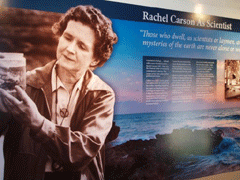
"Awakening Nature's Voice: Rachel Carson 1907-2007" will be on exhibit at the Cape Cod Museum of Natural History through November 30, 2007. (Courtesy of Bruce Gellerman)
VIDEO: Her 1962 book “Silent Spring” challenged American agriculture and caused society to re-think it’s relationship to the natural world, she was far ahead of her time, her work changed the world forever
GELLERMAN: Time Magazine later named Rachel Carson one of the most influential people of the 20th Century and yet, says Bob Dwyer, when the Museum began to work on the Carson centennial exhibit curators were surprised by what they found.
DWYER: What we thought is that people would remember who Rachel Carson was and we were basically going to have a modest exhibit. And what we learned as we started to put this together is that folks just did not remember who Rachel Carson was. And we realized that we had an incredible opportunity to tell a story, bring somebody back to life that is really the head of the environmental movement as we know it.
GELLERMAN: The Carson exhibit on Cape Cod is a collaboration with the U.S. Fish and Wildlife Service.
KLINGER: We have so much stuff that even a lot of it is not gonna be able to go on display because we don’t have the room.
GELLERMAN: David Klinger is a senior writer with the service. In the basement of the museum, Klinger rummages through boxes of Carson’s files and photos. There’s a replica of the brass diving helmet Carson wore while doing research at the Marine Biological Laboratory in nearby Woods Hole.
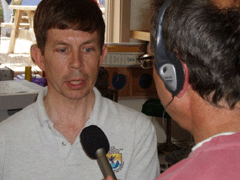
David Klinger, Senior Writer at the USFWS (Courtesy of Bruce Gellerman)
Klinger finds a piece of paper. It’s a Fish and Wildlife press release from 1946 which Carson - as Editorial Director of the Service - helped write:
[PRESS RELEASE READING]
GELLERMAN: Government press releases like this one contained the seeds that would later grow into the book Silent Spring. But these early warnings fell mostly on deaf ears.
[Paul J. Smith (composer) “Leave It To Beaver (Theme)” from ‘All Time Top 100 TV Themes’ (TVT – 2005)]
GELLERMAN: Post World War Two America was a place of unbridled faith in science and technology. Nuclear power promised electricity too cheap to meter. It was an era of “better living through chemistry,” and Dave Klinger says synthetic pesticides like DDT played a big part.
KLINGER: You’re not only looking at a chemical compound but you’re looking at an attitude in the 50’s and 60’s that said chemicals are all good for you but there weren’t as many warnings being sounded about the downside of these things.
[RUMMAGING THOUGH A BASEMENT]
GELLERMAN: Klinger reaches behind a box and finds evidence of what he’s talking about, an old hand-pump spray can that was once filled with insecticide.
KLINGER: Take a look at these pesticide containers. Virtually all of them have five to 15 percent DDT in them, which is really what she wrote about in “Silent Spring.” This is the kind of stuff that was commonly sold in drug stores and grocery stores.
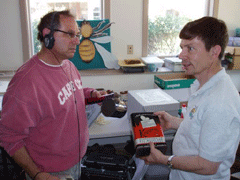
David Klinger holds a can of "Keyspray" insecticide spray. (Courtesy of Bruce Gellerman)
KLINGER: Well they certainly encourage you. It says it’s an extremely effective, pleasantly scented insect spray. But I mean, it was almost comical some of these brand names and how the only good insect was a dead insect.
GELLERMAN: Synthetic pesticides, like DDT were created as weapons during World War II. But Rachel Carson knew they could also be weapons against nature. DDT, Carson said in “Silent Spring,” was not an insecticide but a Biocide.
CARSON: We spray our elms and the following springs are silent of robin songs. Not because we sprayed the robins directly but because the poison traveled step by step through the now familiar elm leaf, earthworm robin cycle.
GELLERMAN: Carson said DDT and other synthetic pesticides were also killing beneficial insects, like honeybees, wreaking havoc on birds of prey, like bald eagles, and working their way up the food chain poisoning people, and disrupting our endocrine systems. “Silent Spring” hit like a bombshell. The chemical industry vilified Carson. She was called an irresponsible woman. The largest manufacturer of DDT said she wrote, quote: “Not as a scientist but rather as a fanatic defender of the cult of the balance of nature.” Every effort was made to discredit her.
[RUMMAGING SOUNDS]
GELLERMAN: David Klinger searches for another box and pulls out a document pages sandwiched between plastic sheets. We came across her FBI file. It’s a two-page letter. That ah…
GELLERMAN: You can’t read it, it’s all been redacted it’s all blacked out. Yes, Dec. 11.
KLINGER: It looks like 11th or 14th 1962.
GELLERMAN: It says US Department of Justice Federal Bureau of Investigation. The New York office of the Immigration and Naturalization Service advised on August 30, 1962 that…and the rest of the page is
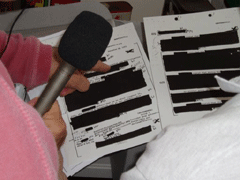
Rachel Carson's FBI file. (Courtesy of Bruce Gellerman)
GELLERMAN: That’s it. There’s nothing else of substance in the FBI document. But at the height of the cold war a link to Russia was enough to discredit anyone.
[MUSIC: Bob Dylan “The Times They Are A Changin’” from ‘The Times They Are A Changin’’ (Sony Music – 1964)]
GELLERMAN: In 1962, the civil rights movement was gathering steam. The anti-Vietnam war movement still lay ahead. Rachel Carson and the fledgling environmental movement, which “Silent Spring” helped spearhead, were at the front lines of dramatic social change in the US.
Bob Dwyer of the Cape Cod museum:
DWYER: I think what Rachel was trying to explain to people is that just because the government is trying to tell you something is ok doesn’t mean it’s ok. Ah, if you have some reason to question something, it’s your duty to do exactly that.
KLINGER: Rachel Carson was, she was a lone woman
GELLERMAN: Again David Klinger.
KLINGER: A lonely voice in the late 50’s and early 60’s getting into some pretty heavy weight subjects that really challenged government and agriculture and industry.
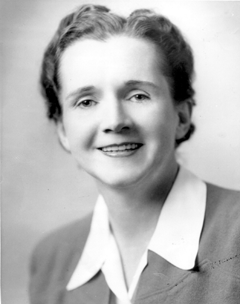
Rachel Carson (Courtesy of U.S. FWS)
GELLERMAN: After “Silent Spring” was published, President Kennedy convened a special commission to investigate pesticides. Klinger pulls out a picture of the panel.
KLINGER: And you notice of course that every member of the committee is a white male except for one woman at the tail end of the table, and that’s Rachel Carson.
GELLERMAN: Carson testified before the committee, which ultimately issued a report warning against the indiscriminate use of pesticides. She also appeared before the Senate, calling for the creation of a federal pesticide agency. By the end of the decade, Congress created the Environmental Protection Agency, which was given jurisdiction over pesticides. In 1972, the sale of DDT was largely banned in the US. And now, 35 years later, bald eagles may finally be taken off the endangered species list.
Still, in the decades since Carson wrote “Silent Spring,” the amount of synthetic pesticides used in the nation has doubled and they’re still part of everyday life. You can even find them here in the basement of the Museum of Natural History, where Rachel Carson’s archives are temporarily stored
KLINGER: Right over there is a can of OFF!
GELLERMAN: And that’s part, in your office, and that’s not part of the exhibit.
KLINGER: No, no, we still use chemicals. I mean, there is a place for chemicals.
GELLERMAN: Rachel Carson agreed if she was misunderstood by the chemical industry, well she was sometimes misrepresented by the fledgling environmental movement as well.
CARSON: Anyone who has really read the book knows that I do not advocate the complete abandonment of chemical control, that I criticize modern chemical control, not because it controls harmful insects but because it controls them badly and inefficiently; and because it creates many dangerous side effects in doing so. I criticize the present methods because they are based on a rather low level of scientific thinking. We really are capable of much greater sophistication in our solution to this problem.
GELLERMAN: Less than two years after Rachel Carson gave this speech at the National Women’s Press Club she died of breast cancer, which she battled quietly while writing “Silent Spring.” The book has never gone out of print.
GELLERMAN: David Klinger, from Fish and Wildlife.
KLINGER: You know, the power of this woman is in her words and what she wrote was not is not in a dusty old book from 50 years ago, it’s as contemporary as today.
GELLERMAN: Rachel Carson: environmentalist, scientist and journalist, would have been 100 years old this week.
The Rachel Carson exhibit at the Cape Cod Museum of Natural History in Brewster, Massachusetts, is on display through November.
For Living on Earth, this is Bruce Gellerman.
[MUSIC: Bob Dylan “The Times They Are A Changin’ (Refrain)” from ‘The Times They Are A Changin’’ (Sony Music – 1964)]
CURWOOD: You can find a link to the Rachel Carson exhibit as well as a set of readings from her book “The Sea Around Us” on our website, l-o-e dot O-R-G.
Related links:
- The Cape Cod Museum of Natural History
- USFWS: Rachel Carson
- Rachel Carson's FBI files
- "The Life and Legacy of Rachel Carson"
CURWOOD: Just ahead it’s alive and living in the La Brea Tar Pits of Los Angeles. Stay tuned to Living on Earth.
[MUSIC: Country Cooking “Trouble Among The Yearlings” from ‘Harlan County USA: Songs of the Coal Miner’s Struggle’ (Rounder Records - 2006)]
CURWOOD: It’s Living on Earth. I’m Steve Curwood. Coming up coal communities in West Virginia confront a looming environmental disaster. But first, here’s this week’s note on emerging science, from Meghan Vigeant.
Emerging Science Note/La Brea Tar Pits
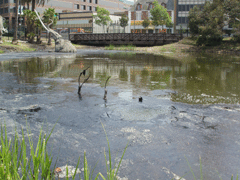
Methane bubbles reveal signs of life in the asphalt of La Brea Tar Pits in Los Angeles, California. (Photo: Ingrid Lobet)
[SOUND OF TAR PIT BUBBLES]
VIGEANT: It’s alive! And it’s living in the toxic soup of Rancho La Brea Tar Pits in the heart of Los Angeles
The tar pits have long attracted tourists for the Ice Age fossils found there, things like mammoths and saber-toothed cats, but the most recent finds weren’t fossils. They’re very much alive. 200 new species and even some whole new families of bacteria have been discovered living in the bubbling pits.
[SCIENCE NOTE THEME]
VIGEANT: Calling it The La Brea Tar Pits actually is a little misleading and kind of redundant, since La Brea means “the tar” in Spanish, which makes it “The The Tar Tar pits”. And it turns out that the stuff in the tar pits actually isn’t tar, it’s asphalt that seeped up from petroleum deposits and formed hundreds of sticky pools
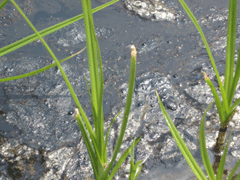
Methane bubbles reveal signs of life in the asphalt of La Brea Tar Pits in Los Angeles, California. (Photo: Ingrid Lobet)
The bacteria are living in extreme conditions; no oxygen, very little water and a soup of toxic chemicals. The researchers have also found that some of the new bacteria can survive in highly saline and radioactive environments. This hardiness and their appetite for the petroleum goop of the tar pits means they may be useful for such applications as cleaning chemical spills and oil recovery. For now their dinner is served at The La Brea Tar Pits.
[SOUND OF TAR PIT BUBBLE]
VIGEANT: Oh, excuse me. That’s this weeks note on emerging science I’m Meghan Vigeant.
Learning In the Shadow of Coal
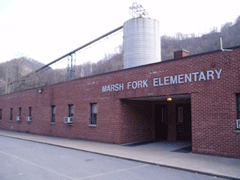
Learning in the shadow of coal. A Massey energy company coal silo looms over Marsh Fork Elementary. The company wants to build a second silo even closer to the school. (Photo: Jeff Young)
CURWOOD: Back in February of 1972, more than 100 million gallons of toxic liquid waste from coal mining operations broke through a dam in West Virginia’s Logan County and rushed down Buffalo Creek.
SURVIVOR: I took off running and warned the people down the creek as I went that the water was coming. They wouldn’t believe me and I told em’ I said well look there you can see the house coming down the creek, but still they didn’t believe me. There was many lives lost, this is the most tragic thing I’ve ever seen in my life. I’m sorry that God let me live to see it.
CURWOOD: The black water tore through the Buffalo Creek ravine killing 127 people injuring more than a thousand and destroying more than five hundred homes. Out of the Buffalo Creek disaster came improved standards and oversight of what are known as coal “slurry impoundments.” But safety and environmental concerns persist to this day. There are still roughly 150 of these toxic lagoons in the region, many of them associated with what are known as mountaintop removal coal mines. Folks in the tiny West Virginia community of Marsh Fork are especially concerned about a massive coal slurry impoundment: If the dam should break it would almost instantly flood the local elementary school. Living on Earth’s Jeff Young traveled to Marsh Fork for the latest story in our series, Generating Controversy: the Changing Climate of Coal.
[FEET TRAMPING, BREATHING SOUNDS]
YOUNG: For a grandpa, Ed Wiley can cover a lot of ground. I can barely keep his wiry frame and camouflage cap in view as we hoof up a ridge near his home. He has mercy and stops for a swig of water.
WILEY: I’m winded, too.
YOUNG: You’re just saying that to make me feel good.
[BIRD SONG]
YOUNG: A thrush and cardinal sing in the oak and hickories; May apples and fiddlehead curls of fern hide our boots. Wiley walks these woods a lot, looking for bear or turkey, mushrooms or ginseng, or sometimes, just peace of mind.
WILEY: I feel protected here and it don’t happen every time, usually when I’m alone, but you get the presence of the Lord, you know, touchin’ down on you. And I don’t get it nowhere’s else.
YOUNG: He won’t find the Lord or bear or anything else here much longer.
[WIND BLOWING IN THE TREES]
YOUNG: This mountaintop and everything on it is being removed in the search for coal.
WILEY: They’re just leveling our mountains in here just literally leveling them with the type of mining they’re doing.
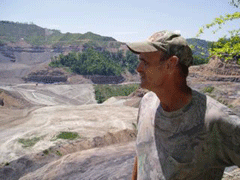
"Like maggots eating our mountainsides." Ed Wiley looks over the mountaintop removal mine just above Marsh Fork Elementary. The ridgeline in the distance will soon be leveled by explosives and the rock and dirt dumped in the valley below.(Photo: Jeff Young)
YOUNG: We crest the ridge, the wind picks up and the land simply falls away. A crumbling, man-made cliff called a highwall drops to a rock and dirt pit hundreds of yards across. On the far side another cut reveals seams of coal between layers of rock. The top of that hill is scalped of trees.
WILEY: I would say by the middle of summer that mountain there will be gone. It’ll all be gone. The ridge that you’re walking on is gonna be gone, too.
YOUNG: And down below all this is where your granddaughter went to school?
WILEY: Right. Yeah, just it’s less than a half-mile from where we’re standing here.
YOUNG: Wiley’s granddaughter Kayla was a student at Marsh Fork Elementary, just beside this mine’s coal preparation plant. Just beyond that is a 350-foot tall dam built from the rock and earth remains of these hills. The dam holds back a lagoon of semi-liquid waste left over from washing the coal.

Learning in the shadow of coal. A Massey energy company coal silo looms over Marsh Fork Elementary. The company wants to build a second silo even closer to the school. Some parents think the mine is a health and safety risk. School principal Louise Maynard says, "we are all going to die of something." (Photo: Jeff Young)
WILEY: And when you’ve got 2.8 billion gallons of toxic sludge sitting over an elementary school, it’s not good. It’s sad, it’s very very sad what’s happened here. The best way I can say it is, is it looks like to me like a bunch of maggots eating away at our mountainsides. And we have them all around us here. If you get up in an airplane the farther you look the more you’ll see.
[AIRPLANE ENGINE]
YOUNG: I take Wiley’s advice and get an aerial view thanks to Sue Lapis, a volunteer pilot with a conservation group called Southwings. We fly from Charleston, the state capital, over forested hills like ocean waves. When we reach mining country those hills look more like flat-topped mesas. One after another has been blown apart. Lapis points out a dragline crane higher than a ten-story building. Trucks with tires as tall as men dump rock and earth into valleys below.
LAPIS: (on head set) now all they have to do is keep blasting and keep harvesting coal until the mountain is gone. What a nasty way to get electricity!
YOUNG: Coal provides about half the country’s electricity, and Appalachia provides more than one-third of the country’s coal.
A government study found that at least 800 square miles of mountaintop have been removed and some 12 hundred miles of streams polluted or completely buried by mine waste. At this rate mountaintop removal will affect nearly one and a half million acres - an area the size of Delaware - by the end of this decade.
Lapis dips a wing to circle the mine above Marsh Fork. The school looks like a tiny box; the waste lagoon a bruise on the raw earth.
LAPIS: My view as a pilot is to look up into this amazing destruction that’s above the school and there’s a gigantic slurry dam impoundment right there; an amazing juxtaposition of children and environmental catastrophe. What are they thinking?
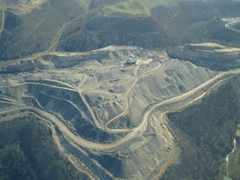
"Nasty way to get electricity," pilot Sue Lapis says as she looks down on one of the many mountaintop removal mines transforming the Appalachian landscape. The dragline crane near the top of this photo stands taller than a ten-story building. (Photo: Jeff Young)
YOUNG: Not long ago Ed Wiley didn’t give much thought to any of this. He used to work on the mine with a contracting company, getting good money and - for the first time in his life - health insurance.
Then his granddaughter started getting sick at school—pale with headaches and fatigue.
[OUTDOOR SOUNDS]
YOUNG: When he took her home early from school for the third time he noticed what seemed like a lot of names on the student sign-out book - a lot of kids going home sick. He buckled Kayla into the seat of his pickup.
WILEY: And she turns and looks at ya and tears are pourin’ down this little girl’s eyes. And she says, gramps these coalmines are making us kids sick. That hurt. That hurt me. You know, it took her tears to wake me up. And it was like a sledgehammer.
YOUNG: It’s still not clear what might be making school kids sick. An independent air test found coal dust in the school. But other government tests found nothing that could account for illnesses.
Wiley thinks it has to do with the blasting and dust, and the hazardous warning labels on chemicals he’d seen at the mine and its prep plant. And then there’s the dam. Wiley heard troubling stories from workers about its construction and safety violations against the company. He thought of all the rainwater that will run from the mined land adding pressure on the dam during storms. He saw it all pointing to trouble for the little school.
[SCHOOLYARD, CHILDREN PLAYING, JUMPING ROPE]
CHILDREN: Cinderella dressed in yellow went upstairs…
YOUNG: Like nearly everything else here, Marsh Fork Elementary sits on the scarce flat land between the main road and the creek, in the narrow valley carved by a branch of the Coal River. Looming above the school is the silo of the coal company’s preparation plant. Coal is washed with a chemical bath to remove impurities, and stored in the silo. Then it’s sprayed with more chemicals to keep it from freezing in winter, to keep it in place on train cars. This happens less than 300 feet from where these children play.
DYE: What can I say? I mean it’s the major source of industry. It’s the major source of jobs. Without the coal mining nothing functions around here.
YOUNG: Dennis Dye teaches physical education at Marsh Fork. Dye says air quality tests and a visit to the mine convinced him that Wiley’s safety concerns are overblown.
DYE: I guess there can never be a guarantee that a slurry impoundment won’t fail. But I’ve been up there and there will be a lot of other things in this state fail before that impoundment fails.
[SCHOOL KIDS IN HALLWAY]
YOUNG: The main fear from staff is that the controversy about the mine will end up closing the school. Principal Louise Mollohan Maynard would much rather be bragging about her students going to a state math fair than talking about safety issues with a reporter.
MAYNARD: Probably the thing that bothers me the most is the outsiders. And I think we have a lot of outside influences that are causing us a lot of problems.
YOUNG: That mine is enormous and the impoundment is enormous. In the past those things have failed. Doesn’t that bother you?
MAYNARD: I was raised in a coal mining town my father was a coal miner and you get used to some things when you live in this area just like people do who live in the, around steel plants, or whatever the circumstances are. And I pray nothing ever goes wrong, but there is no guarantee of that with anything. And we are all brought into this world and the minute we come into this world then we begin the process of going out of this world. We’re all going to die of something, whether it’s old age, natural cause, falling off our front porch, a flood. We’re all going to leave this earth someway.
YOUNG: Federal law clearly forbids coal mining within 300 feet of a school. But Randy Huffman of the West Virginia Department of Environmental Protection explains this mine and the school predate the law.
HUFFMAN: It was there before mining was regulated and when the law was passed to regulate mining it was grandfathered.
YOUNG: That was 1977. The mine then was nothing like the one today. Then it was an underground mine. And it was not owned by Massey Energy, the nation’s fourth largest coal producer.
Even in an industry where safety and environmental problems are common, Massey’s record stands out. This month the federal government sued Massey for more than four thousand violations of the Clean Water Act—possibly more than a billion and a half dollars in fines.
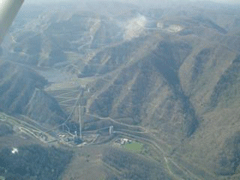
The Massey energy coal company's slurry impoundment and dam. The small white square in the lower foreground is Marsh Fork Elementary. In 2000, another Massey-owned impoundment failed, releasing tons of liquid waste. "It just does not make sense," mine safety expert Davitt McAteer says, "to put a school and impoundment in close proximity." (Photo: Jeff Young)
Yet Huffman declines to say that Massey’s impoundment at Marsh Fork warrants extra attention.
HUFFMAN: I don’t make judgments about who we should trust and who we shouldn’t. We are tasked with enforcing the law based upon certain parameters and permit requirements. I do feel that the children are safe from the impoundment breaking through. To the degree that that helps anyone feel better, I’m confident that the children are safe.
YOUNG: Huffman’s agency is trying to stop Massey from building a second coal silo at Marsh Fork, this one even closer to the school. The matter is under appeal.
Massey representatives did not respond to several interview requests for this story.
During the Clinton administration Davitt McAteer directed the federal mine safety and health administration, the country’s top coal safety watchdog. McAteer’s now a vice president for Wheeling Jesuit University, where he compiled a comprehensive database of coal impoundment safety - all the failures, slurry spills and other incidents.
MCATEER: The Massey company has a higher rate of failures, failure-slash-incidents, than any other company that operates impoundments in the country. Those are the facts.
YOUNG: McAteer says he sees no evidence of imminent danger of failure at the Marsh Fork impoundment. But he remembers the tragedy at Buffalo Creek. And he knows that dams of this nature are ten times more likely to fail than the concrete dams most people are familiar with.
MCATEER: It just isn’t logical and isn’t - I don’t think it’s very responsible to put an impoundment and a school in proximity to one another. Failures are rare but failures do exist. And so why do we put the children in harm’s way? It just makes common sense, it’s logical to take the children out of harm’s way and that makes the most sense to me.
YOUNG: That makes sense to Ed Wiley, too. He organized “pennies of promise,” a campaign to raise money to move the school to a safer place. It’s been difficult, he says.
WILEY: It’s hard to get people that’s dependent on this for work, their livelihood, to speak out. It’s a tough issue. I feel this is willfully and knowingly leaving these kids in harm’s way. This is a form of child abuse at its highest level.
YOUNG: Wiley took his concerns to West Virginia Governor Joe Manchin. Manchin ordered some health testing at the school and fought Massey’s attempt to build a second coal silo at Marsh Fork. But time dragged on with no commitment from the governor for a new school. So Wiley joined a group of demonstrators and occupied the governor’s office at the capitol.
DEMONSTRATORS: What do you want? A new school in Marsh Fork community.
YOUNG: Manchin had state troopers haul the demonstrators away.
[SOUND OF DEMONSTRATORS CHANTING. “SHAME” AS PROTESTERS ARE ARRESTED. A YOUNG WOMAN SHOUTS IN PAIN.]
YOUNG: Wiley contacted his congressman, Democrat Nick Rahall. Rahall chairs the powerful House committee on Natural Resources and is a strong supporter of coal.
RAHALL: Yes coal provides a livelihood to a vast number of people in my district and in West Virginia. Yes, coal is a friend to West Virginia.
YOUNG: Rahall helped write surface mining law thirty years ago. It allows mountaintop removal mining but requires that the reclaimed mine sites be put to good use.
RAHALL: It happens to be in some parts of our country like in southern West Virginia flat land is at a premium. And where we have mountaintop mining is done in a responsible manner. We have very good public works on top of those sites. It’s not like you’re just whacking down mountains and you’re doing it in an irresponsible fashion.
YOUNG: After years of requests to state and federal officials Ed Wiley had run out of patience. But not out of energy. He put a “pennies of promise” banner over his shoulder and put his boots on the road. And he walked all the way to Washington D.C.
[CHEERING OF SUPPORTERS]
YOUNG: Supporters cheered him along the last steps of his 450-mile, 40-day hike to Capitol Hill.
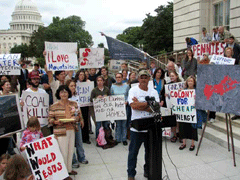
The kids in coal country "deserve a safe, healthy place to go to school," Ed Wiley says on Capitol Hill. He walked all the way from his West Virginia home to raise awareness about Marsh Fork Elementary. (Photo: Vivian Stockman)
[BIG CHEER]
YOUNG: In the months since Wiley’s long walk mountaintop removal mining opponents won an important court victory. The federal court decision could force more thorough environmental review before mines receive federal permits. Congress is considering clean water legislation that would limit the waste rock and dirt dumped into streams.
Wiley raised some money and gained some allies for his campaign, but the school has not moved. The children of Marsh Fork still get their lessons in the shadow of coal.
For Living on Earth, I’m Jeff Young in Marsh Fork, West Virginia.
[MUSIC: Doc Watson & Gaither Carlton “Am I Born To Die?” from ‘Harlan County USA: Songs of the Coal Miner’s Struggle’ (Rounder Records - 2006)]
Related links:
- Database on coal slurry impoundments compiled by safety expert Davitt
- Multi-agency federal study of mountaintop removal mining
- Appalshop's documentaries on the Buffalo Creek disaster
- Ed Wiley's Pennies of Promise campaign
- West Virginia coal Association
- Video: "Marsh Fork Protests Leads to Capitol Arrests" on YouTube
CURWOOD: Coming up a country singer returns to her coal country roots. That’s just ahead on Living on Earth.
ANNOUNCER: Support for the environmental health desk at Living on Earth comes from the Cedar Tree Foundation. Support also comes from the Richard and Rhoda Goldman Fund for coverage of population and the environment. This is Living on Earth on PRI—Public Radio International.
[MUSIC: J.P. Fraley “One Morning In May” from ‘Harlan County USA: Songs of the Coal Miner’s Struggle’ (Rounder Records - 2006)]
Coal Country Crooner

Kathy Mattea (Photo: Kristen Barlowe)
CURWOOD: It’s Living on Earth. I’m Steve Curwood. Coal runs thick in the blood of many, if not most, West Virginians. Kathy Mattea is one of them. She grew up in West Virginia coal country before heading off to Nashville and a long and successful career as a country singer. Her recordings have been number one on the billboard country music charts time after time. And it’s hard to turn on a country radio station without hearing such hits as “Love at the Five and Dime” and “Eighteen Wheels and a Dozen Roses.”
[MUSIC Kathy Mattea “Eighteen Wheels and a Dozen Roses” from ‘Untasted Honey’ (UMG Recordings - 1987)]
Now in her most recent work, country music star Kathy Mattea is turning her attention back to her roots- acoustic music and coal country. Her latest recording project explores the heritage of her home state … and of her own family in coal mining. Kathy Mattea and her guitar join us now from Nashville.
Welcome to Living on Earth
MATTEA: How you doing?
CURWOOD: Now, you’ve recorded a number of songs that explored the heritage of coal mining. What was your family’s relation to coal mining, your dad’s relationship?
MATTEA: Well, both my grandfathers were coal miners. My dad was the only son. There were six kids in his family and he was the only boy. And uh because my uncle gave him the money to go to school, go to college, he didn’t have to go into the mines. But that was sort of everybody’s, you know, everybody in his town that was sort of what you did. And ah, my mom grew up in a family with six sisters and my grandfather on her side was a coal miner as well. And you know just lots of family stories, lots of family lore and uncles who were in the mines.
CURWOOD: Now in addition to the effects of mining coal and living with coal itself I understand that you’ve also been thinking a lot about the effects of burning coal, specifically its contribution to global warming. Can you tell me about that?
MATTEA: Yeah, it’s been an interesting journey this last year. In January of 2006 I went to see former Vice President Gore give his power point presentation over at Vanderbilt University and ah I didn’t sleep for two nights after that. I mean, I was just haunted by what I had seen and the evidence just seemed so compelling and so overwhelming and I learned to give the slideshow and have been giving it in various settings over the last few months. And ah, it’s interesting, I began to sleep again once I really started taking action. That was the thing I learned along the way was that I feel helpless until I begin to be a part of the solution. And we are each a very important part of this solution.
CURWOOD: Half of the electricity in this country does come from coal, thereabouts, so maybe there’s a 50-50 chance it came from coal, but since you’re in Nashville and I’m in Somerville, Massachusetts probably one of these studios was fired by coal.
MATTEA: Yeah, it’s something that people don’t think about. And here’s the other part of it: the big seams of coal in West Virginia and Kentucky have all been mined. So what’s left are real thin seams and that means strip mining. Strip mining is rampant right now and it’s raping, it’s raping the countryside. What if you knew that every time you flip on your light switch a mountaintop in West Virginia just blows up? It’s crazy. In these rural areas a lot of times that is the best way to make money if you are unskilled labor, if you don’t have a college degree. And so you know, you don’t have a lot of power if you want to stay on the piece of land where your family has been for generations. There’s just a lot to it.

Kathy Mattea live (Courtesy of Mattea.com)
MATTEA: I think the first one was Coal Tattoo, which is a Bill Ed Wheeler song. It’s been around for a long time.
[MUSIC: Kathy Mattea “Coal Tattoo” from ‘Coal’ (Label TBA - 2007)]
MATTEA: Dark as a Dungeon was on the list. And then I just started researching and found some old songs from the sixties and the fifties and found some modern songs and just tried to kind of find a nice mix. My goal was to be able to tell this story and to maybe open up a window into it that people who have not heard these songs before, hopefully they might find some accessibility there.
CURWOOD: What about the story of Lawrence Jones?
MATTEA: Ah. Well, there was a strike in the early seventies in Harlan County and it was horrible. It wound up going on for 13 months. And these people were fired on with machine guns. They were called out of their houses and killed. The whole thing kind of came to a head when one of the, they call them “gun thugs,” one of the people hired by the company to intimidate the strikers, shot a young miner in the face with a shot gun. And he went into the hospital and eventually died after a few days. He had a 16-year-old wife and a new-born baby at the time. And it was sort of the last straw. The miners had been fighting a long time and that was the last straw that got the contract agreed to between the UNW and the company. And this tribute to him which was written by Sy Con is just the most beautiful and reverent and empowering song about people without a lot of options. Just refusing to back down in the face of what they know to be right.
CURWOOD: Would you play it for us now?
MATTEA: I’d be happy to.
CURWOOD: Thank you.
[MUSIC: Kathy Mattea “Lawrence Jones” from ‘Spotland Productions Live In-Studio Performance’ (Nashville, TN – April 2007)]
CURWOOD: Thank you so much. Now you’ve chosen for your coal project a number of songs that well, they just clearly admire people who mine coal who give their lives and their fortunes to mine coal and endure all the hardships that come along with it. But if the United States were to take concerted action on climate change wouldn’t that be kind of hard on the coal mining regions of the country like West Virginia?
MATTEA: Well, I think that’s part of what we have to talk about. We have to try to get into a solution so that we can make some kind of sensible solution to cleaner power. I think there are going to be many facets to the solution. There are people doing research right now on how to burn coal cleaner. So it may not be that we have to eliminate coal, but you know if our appetite for energy is so big right now, that we will blow up mountain tops to the point where we have strip mines in West Virginia as big as half the area of Manhattan. You know these things, it’s not just the beauty of the mountain that’s lost. The Appalachian forest is the most diverse forest in North America. So we’re losing habitat. We’re losing species. The sludge ponds are contaminating the water and then when they blast off the mountain tops and push all of that dirt that is not coal into the valleys it contaminates the water for the people who live in the area. People in West Virginia are screaming about this and people who mine the coal are screaming about this. It is a complex problem. But if we can’t discuss it because we are so married to the way things are, then we can’t find our way to a solution and we must.

Kathy Mattea (Photo: Kristen Barlowe)
MATTEA: Yes.
CURWOOD: You have a song about a bird that you’re lucky to see down there.
MATTEA: (laughs) Yeah, this a, God this is just a wonderful song and it so much speaks to the kind of risk that these miners take every day so we’ll have electricity. You know how much danger these guys work in everyday. And it’s just an eloquent piece written by Billy Ed Wheeler.
MUSIC: Kathy Mattea “Blackbird” from ‘Spotland Productions Live In-Studio Performance’ (Nashville, TN – April 2007)
CURWOOD: Phew…whoa, boy you dig deep into that tune.
MATTEA: Oh man, that tune is so amazing, just an amazing piece of writing.
CURWOOD: As you’ve reflected on doing this coal project on the one hand you see coal giving people jobs and fueling the country. On the other hand of course it’s taken quite a toll on people and your home state of West Virginia. So tell me, is coal a gift or a curse for West Virginia?
MATTEA: Yeah. I think it is and it’s reflected in so many of these songs as well. There is a love-hate relationship all the way across the board. Almost from any angle you slice it. And as I’ve made this project I have a piece of coal sitting on my desk. I just keep kind of looking at it. It’s bituminous coal, it’s all shinny. And ah you know, I thought that’s really good to be able to just reach out and touch it every once in a while. I know what it smells like when it burns. I know how hot it burns. I know what it’s like to go to the railroad track and gather it up. And I feel like this is part of my history and I have kind of a unique position you know: kind of one foot in the modern world and one foot in a kind of older history. And it’s very scary to bring that up in the face of global warming but we have to be able to talk about these things. We have to.
CURWOOD: Kathy Mattea’s next album is called “Coal.” Thank you so much for taking this time.
MATTEA: Thank you for having me. It’s been a pleasure.
[MUSIC: Kathy Mattea “Acoustic Guitar Instrumental” from ‘Spotland Productions Live In-Studio Performance’ (Nashville, TN – April 2007)]
Related links:
- Kathy Mattea's Coal Project website
- Kathy Mattea's official website
CURWOOD: Next time on Living on Earth more than a billion people live off the electricity grid. Many can only get light using expensive and dirty kerosene. Now an American businessman is delivering a simple solution: long-lasting, solar-powered flashlights.
BENT: What I wanted to do was to give to African’s something that empowers them. And it’s an amazing thing. It helps out with education. It helps out with the environment, security in refugee camps. So it really impacts people’s lives in an amazing way.
CURWOOD: Solar flashlights for the developing world, next time on Living on Earth.
[MUSIC: Kathy Mattea “Acoustic Guitar Instrumental” from ‘Spotland Productions Live In-Studio Performance’ (Nashville, TN – April 2007)]
CURWOOD: We’re online whenever you are. The address is l-o-e dot org where you can hear the program or download a podcast anytime. That's l-o-e dot o-r-g. And you can reach us at comments @ l-o-e dot org. Once again, comments @ l-o-e dot o-r-g. Our postal address is 20 Holland Street, Somerville, Massachusetts, 02144. And our listener line is 800-218-9-9-8-8. That's 800-218-99-88.
CURWOOD: Living on Earth is produced by the World Media Foundation. Our crew includes Ashley Ahearn, Eileen Bolinsky, Bruce Gellerman, Ian Gray, Ingrid Lobet, Jennifer Percy, Emily Taylor, Peter Thomson and Jeff Young - with help this week from Bobby Bascomb, Kelley Cronin and Jeff Turton. Our interns are Paige Doughty and Meghan Vigeant.
Dennis Foley is our technical director. Alison Lirish Dean composed our themes. You can find us at l-o-e dot org. I’m Steve Curwood.
And from all of us here at Living on Earth Thanks for listening.
ANNOUNCER: Funding for Living on Earth comes from the National Science Foundation, supporting coverage of emerging science, and Stonyfield Farm organic yogurt, smoothies, and milk. Ten percent of profits are donated to efforts that help protect and restore the earth. Details at Stonyfield dot com. Support also comes from you, our listeners, the Ford Foundation, The Educational Foundation of America and the Saunders Hotel Group of Boston’s Lenox and Copley Square Hotels, serving you and the environment while helping preserve the past and protect the future 800-2-2-2-7-6-7-6.
Living on Earth wants to hear from you!
Living on Earth
62 Calef Highway, Suite 212
Lee, NH 03861
Telephone: 617-287-4121
E-mail: comments@loe.org
Newsletter [Click here]
Donate to Living on Earth!
Living on Earth is an independent media program and relies entirely on contributions from listeners and institutions supporting public service. Please donate now to preserve an independent environmental voice.
NewsletterLiving on Earth offers a weekly delivery of the show's rundown to your mailbox. Sign up for our newsletter today!
 Sailors For The Sea: Be the change you want to sea.
Sailors For The Sea: Be the change you want to sea.
 The Grantham Foundation for the Protection of the Environment: Committed to protecting and improving the health of the global environment.
The Grantham Foundation for the Protection of the Environment: Committed to protecting and improving the health of the global environment.
 Contribute to Living on Earth and receive, as our gift to you, an archival print of one of Mark Seth Lender's extraordinary wildlife photographs. Follow the link to see Mark's current collection of photographs.
Contribute to Living on Earth and receive, as our gift to you, an archival print of one of Mark Seth Lender's extraordinary wildlife photographs. Follow the link to see Mark's current collection of photographs.
 Buy a signed copy of Mark Seth Lender's book Smeagull the Seagull & support Living on Earth
Buy a signed copy of Mark Seth Lender's book Smeagull the Seagull & support Living on Earth

